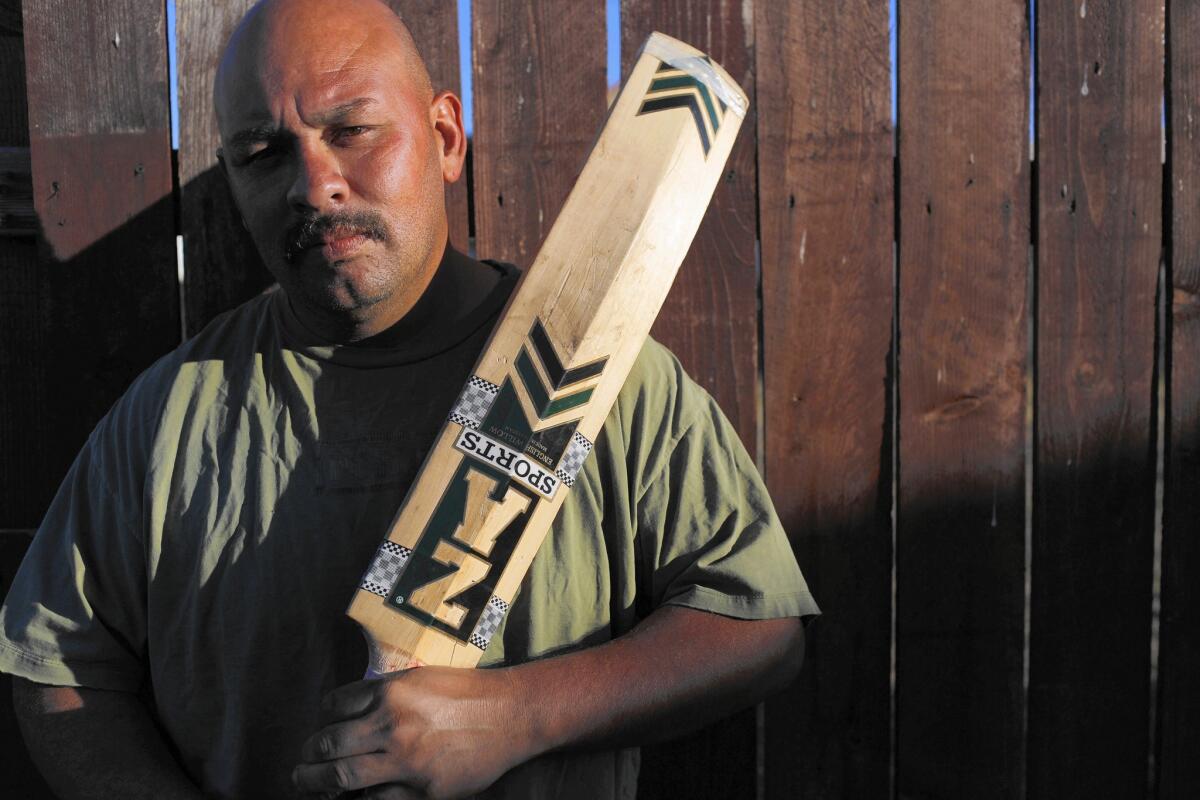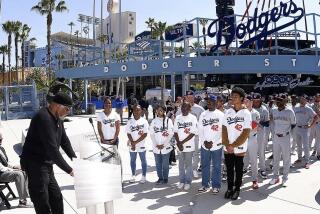English portrait gallery latest stop in Compton Cricket Club’s unlikely journey

The first time someone invited Sergio Pinales to play cricket, he assumed the game involved a race.
“Like you put a bunch of crickets on the floor,” he said. “And you see which one goes the fastest.”
Then a Compton high school student, Pinales, like most Americans, had never heard of the gentlemanly, pitch-and-wicket sport that’s long captivated audiences in England, South Africa and India.
So, nearly 20 years ago, when a few outsiders showed up at his local high school to recruit players, he and the other students were skeptical.
Little did they know their team — a rough-hewn crew called the Compton Cricket Club — would one day travel the globe as ambassadors of the sport.
They never competed professionally. And just how good they were is open to debate. Yet their fast celebrity became the envy of many other U.S.-based cricket teams.
They played matches in England, Australia and Ireland, sipped tea with Prince Edward at Buckingham Palace, competed against aborigines in the remote outback and were featured in newspapers, magazines and television shows.
This month, the team was bestowed with an honor not even Kobe Bryant can claim.
Their painted portraits were unveiled in an exhibit in England’s prestigious National Portrait Gallery.
Images of their faces hang just down the hall from Britain’s most famed figures: Queen Elizabeth, Tony Blair, Anna Wintour.
“I’m speechless,” said Pinales, 35. “Never in a million years would I imagine a picture of me hanging in a place like that.”
This latest honor stemmed from an annual competition, in which the gallery invites artists to propose a series of paintings. Hundreds worldwide took up the challenge.
A painter from London, Edward Sutcliffe, won with his proposal to paint the Compton Cricket Club. Judges said they were intrigued by the fusion of two such different cultures. The exhibit will run at the Gallery through Sept. 20, then travel to museums in Edinburgh and Belfast.
Featured alongside the players are portraits of the team co-founders, homeless activist Ted Hayes and Katy Haber, a film producer.
When Haber and Hayes, who’s no longer with the team, launched the club back in 1995, they never imaged the places it would go. They began the team with homeless guys, then transitioned to teenagers in Compton.
Their goal was to use the chivalrous sport — in which one obeys one’s captain, is polite to the umpire and eschews foul language—to teach respect to kids who were getting lured into gang fights, drug deals, tagging and, in some cases, carjackings and shootings.
“We wanted the etiquette and civility of the game to change the way they think,” Hayes said. “We wanted them to come off the field as improved citizens at home, school, work.”
The teenagers learned the game in rough, uneven fields around Compton. Haber and Hayes would drive each of them to practice so they could avoid walking through dangerous gang turf.
Their trips to England were whirlwhinds, made possible by mostly British donors including Prince Edward, Queen Elizabeth’s son, whom Haber and Hayes had met through previous work with the homeless.
When the prince invited the team to Buckingham Palace, the British media reveled in the unlikely story — boys from Compton, the land of gangsta rap and gangster shootings, were in town to play cricket, England’s most stately sport. On several occasions, they stopped by for tea with the prince.
The team is mostly dormant now. Or “in transition” as Haber says.
The problem, she says, is that even while the team was abroad, signing autographs and attending press conferences, here in Los Angeles there just wasn’t enough money coming in from schools, businesses and city leaders to keep the Compton Cricket Club going.
Also, the Los Angeles cricket community, made up of lots of ex-pats, wasn’t the most welcoming, Hayes and Haber said.
Some criticized the team for being a publicity fad.
“They were like a meteorite,” said Kamal Azees, former president of the Southern California Cricket Assn. “They would get a lot of attention when they traveled, then they would go away.”
Other local cricketers are quick come to the club’s defense. Paul Severn, a third-generation player who’s also president of the Los Angeles Social Cricket Alliance, said the Compton players did plenty to promote American cricket.
“No one else has done as much as they’ve done with so little,” he said. “And they did it with so much heart.”
Many of the core players who stuck around from the start are now in their 30s — plumbers, truck drivers and foremen who are too busy with wives and kids to make time for the game that changed their lives.
But Haber is determined to revive the program. She’s hopeful that the prestige of the portraits will motivate others to help her.
“Here’s something that became incredibly successful and transformed the lives of these young men, “ Haber said. “Now there’s a whole ‘nother world of guys out there who need it.”
“People treated us with so much respect,” said team captain Emidio Cazarez, 33. “They knew we weren’t real cricketers, but when we’d come out and play other teams, they would cheer for us the loudest.”
The players recall being escorted into a room filled with velvet and gold. They had to be prepped on how to bow, how to address the prince and how to hold a teacup.
“I remember holding it like a soda can,” Pinales said. “And just downing it.”
They were so young then, many of the players said the magnitude of those moments didn’t sink in until years later.
“Those experiences really opened my eyes,” Cazarez said. “I could get out of Compton. I could go beyond the limits I set for myself. I could exceed.”
“It’s been a crazy adventure,” Pinales said. “If it wasn’t for cricket, God only knows where we’d be.”
For some players, those lessons didn’t sink in easily.
Ricardo Salgado, now 32, returned from one England trip and soon took part in a drive-by shooting. He shot a man and ended up serving six years in prison. He became a cautionary example for the team.
In 2002, he got out of prison, rejoined the club and helped them win several local championships.
“In life, you get only one chance,” Salgado said. “Just like in cricket, you get only one out.”
The father of two now lives in a small town in Illinois. He works as a department trainer at a car parts manufacturer and is studying to be an industrial technology engineer.
Sutcliffe, the artist, heard about the team on the radio as he worked in his studio. He traveled to Illinois to meet Salgado, then to Los Angeles, where he photographed and sketched the players. They welcomed him with a barbecue and an evening full of stories.
His almost regal portrait of Salgado has been the highlight of the London exhibit. It shows the unlikely cricketeer stoically looking straight ahead as he clasps a flat-faced bat in his right hand. He wears white cricket pants and sits, legs spread and shirtless. “COMPTON” is tattooed in large letters across his chest.
Salgado’s portrait, said Sutcliffe, “seems to encapsulate what Compton Cricket Club is about.”
esmeralda.bermudez@latimes.com
Twitter: @LATbermudez
More to Read
Start your day right
Sign up for Essential California for news, features and recommendations from the L.A. Times and beyond in your inbox six days a week.
You may occasionally receive promotional content from the Los Angeles Times.







